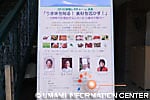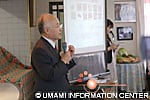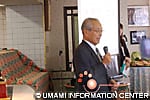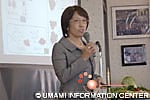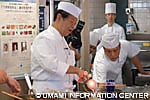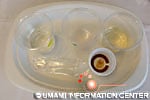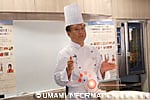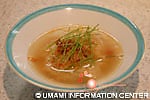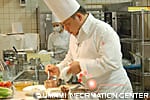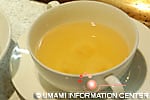[Lecture report] 2013 Umami Lecture in Hamamatsu "Learn about Umami! Make the best use of food ingredients!" - Charm of food ingredients produced in the land of Mt. Fuji enhanced by Umami -
December 2013
NPO UMAMI Information Center held the "2013 Umami Lecture in Hamamatsu" at 1pm on November 22 (Fri) in collaboration with Tokai Cooking and Confectionery College.
This lecture is the 3rd collaborative event with cooking colleges, following Niigata and Fukuoka. In this lecture, experts of Japanese food, Chinese food, and French food discussed the attractions of the Fuji country extracted by umami while incorporating talks and cooking demonstrations to promote better understanding of umami for food specialists, such as cooks, chefs, nutritionists, cooking college faculty members, and cooking researchers, etc.
Mr. Mizumoto, Chairman of the Mizumoto Gakuen Educational Association
Dr. Ninoiya,
Director of the
Umami Information Center
The lecture opened with the MC by Ms. Shizuka Matsushima of Tokai Cooking and Confectionery College. Following the greetings by the hosts, including Chairman Kenzo Kurihara of UMAMI Information Center and Chairman Shigetomo Mizumoto of Mizumoto Gakuen Educational Association, Director Ninomiya of UMAMI Information Center gave the umami lecture.
In the umami lecture, Director Ninomiya explained the 5 basic tastes, characteristics of each taste material, and umami material in food. Participants experienced what exactly umami tastes like by sampling cherry tomatoes. Next, she explained the characteristics of different dashi based on the difference of amino acids and umami ingredients contained in Japanese food dashi, Western food bouillon, and Chinese food stock and introduced the uses of umami, such as concentration and accumulation of umami material, by using fermentation and curing as examples. Furthermore, she used vegetable bouillon and compared the bouillon with 0.2% salt and bouillon with salt as well as 0.05% MSG (monosodium glutamate), which is an umami material. Participants compared the samples to experience the effect of umami. Director Ninomiya went on to introduce words by overseas chefs on umami characteristics, such as "subtle," "faint," "delicate taste," "pleasant aftertaste and sense of satisfaction," "long-lasting taste," and "taste that spreads throughout the mouth or tongue," etc. She explained examples of chefs throughout the world seeking new umami materials for the concept of "tasty and healthy" by utilizing umami.
Next, Mr. Yoshihiro Murata of Japanese food, Mr. Yuji Wakiya of Chinese food, and Mr. Hiroshi Yamaguchi of French food performed demonstrations on dashi/soup utilizing umami in each food as well as demonstrations of cooking that brings out umami in food ingredients of the Fuji country by using the dashi/soup.
In the lecture by Mr. Yoshihiro Murata, the owner of "Kikunoi," participants experienced the synergy effect of umami by using kombu dashi (seaweed broth) and dried bonito flakes in response to the umami lecture by Director Ninomiya in the beginning. Participants drank half of the kombu dashi, which was distributed, and next they thoroughly chewed dried bonito flakes in the mouth. When they drank the remaining kombu dashi again afterward, they experienced much stronger umami than the kombu dashi they tasted at first. This is the synergy effect, which is one of umami's functions.
Next, he discussed dashi ingredients that he uses when he gives lectures overseas. He explained that he sometimes makes dashi by using food ingredients available in the country because kombu and dried bonito flakes may not always be available overseas when he makes the first dashi. Following this discussion, he introduced the very first "Shizuoka Dashi" in the demonstration by using vegetables, such as dried morel mushrooms, hakusai (Chinese cabbage), and daikon (Japanese radish), etc., and minced chicken breast. Furthermore, he introduced how to make soy sauce-style pork rib soy sauce by using this Shizuoka Dashi and applying French food cooking method. Participants sampled both. He then performed a cooking demonstration for white chawanmushi (steamed egg hotchpotch) with Shizuoka Dashi, pork rib soy sauce, egg white, and soy milk, etc. as a sample menu. The venue was filled with the participants' voices of surprise and admiration for Mr. Murata's new idea and cooking method.
Following Mr. Murata, Mr. Yuji Wakiya, Owner Chef of "Wakiya Ichiemi-charo," went up on the stage.
Chef Wakiya's lecture began with the cooking demonstration of stock, which is a representative dashi in Chinese food. He explained that he began adding kombu approximately 10 years ago as one of the ingredients in addition to Jin hua huo tui, pork shin meat, and whole chicken (ro-chi) and that umami was significantly enhanced with the synergy effect between the inosinate in the pork ribs and chicken and the glutamate in the Jinhua ham and kombu, enabling him to make tastier Jinhua stock. Furthermore, participants sampled unique "Gyokuro-jinhua stock" by combining this stock and Gyokuro green tea, which is a specialty of Shizuoka, with a 4:6 ratio.
Next, he performed a cooking demonstration for Spotted shrimps XO source (XO sauce with spotted shrimps and dried scallops) by using fresh Sakura shrimp, which is a specialty of Shizuoka, dried adductor, garlic, shallot, and fresh red pepper. Tasty sauce was made with the umami synergy effect between the inosinate in the fresh Sakura shrimp and the glutamate in the dried adductor and garlic, etc. When he topped this XO sauce using Sakura shrimp and dried adductor over white rice in a bowl and poured the hot Gyokuro-Jinhua stock, "Gyokuro Shantan Rice" was done. The venue was filled with the participants' voices of admiration for the umami synergy effect by Shizuoka's food ingredients, including the XO sauce using Sakura shrimp and dried adductor and Gyokuro-Jinhua stock.
The last lecturer on the stage was Mr. Hiroshi Yamaguchi, General Manager/Executive Chef of "Kobe Kitano Hotel."
The lecture by Chef Yamaguchi, who is a leading expert of French food, started with the experience of umami synergy effect using chicken consomme and tomato water. Tomato water, which had been frozen in a semispherical form and coated with vegetable gelatin, was placed on top of the chicken consomme. Participants were able to first experience the inosinate of the chicken consomme in the mouth and then the umami synergy effect of the inosinate and glutamate of the melted tomato water mixing together in their mouth.
Next, he performed a cooking demonstration of "Umami stew of romaine lettuce and pig's feet" by using this chicken consomme. Boiled and deboned pig trotters were filled with Farce (stuffing), which is made with pork ribs, champignon, and shallot flavored with egg white, fresh cream, salt, pepper, quatre epice, jus de truffes, and cognac, which were then covered with crepinette (caul fat) and grilled. When they browned, Chef Yamaguchi simmered them with vegetables with a lot of glutamate, such as onions, carrots, and celeries, as well as fond de veau and cut them in cylindrical shapes. Romaine lettuce was simmered in bacon and consomme to go with the arranged pig trotter. The gelatin in the pig trotter and romaine lettuce were filled with umami ingredients, and a dish with plenty of umami was completed. Chef Yamaguchi's elegant and magic-like techniques triggered sighs from participants at the venue.
Afterwards, everyone sampled Chef Murata's "White chawanmushi (steamed egg hotchpotch) -With Shizuoka dashi and pork soy sauce-," Chef Wakiya's "Gyokuro Shantan Rice -Rice with Gyokuro and the highest quality clear soup with spotted shrimps XO sauce-," and Chef Yamaguchi's "romaine lettuce and umami stew of pig trotters." After all participants sampled, the venue was filled with voices of admiration for the dishes using food ingredients of Fuji country extracted by umami.
Finally, the Umami Lecture was completed with the closing speech by Takashi Yamamoto, Deputy Director of the Umami Information Center, after the Q&A for these lectures, comments by the 3 lecturer chefs and Director Ninomiya, and introduction of the assistants who helped with the lecture and faculty members and students of Tokai Cooking and Confectionery College.
On the day of the lecture, 81 people participated at the venue in Tokai Cooking and Confectionery College. Participants shared many positive evaluations with us, such as "We were able to gain good understanding of umami, which is common in Japanese food, Chinese food, and French food," "We enjoyed the tasty food made by top chefs by utilizing umami," and "We would love for this to be held again," etc. In addition, scenes from these lectures were covered by the Chunichi Shimbun and the Shizuoka Shimbun on the following day. They are also scheduled to be introduced in the February edition of the monthly magazine "CUISINE KINGDOM."
UMAMI Information Center will continue to promote these activities in order to promote understanding and dissemination of umami. We thank you in advance for your continuous support.
